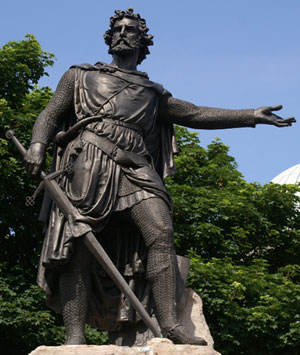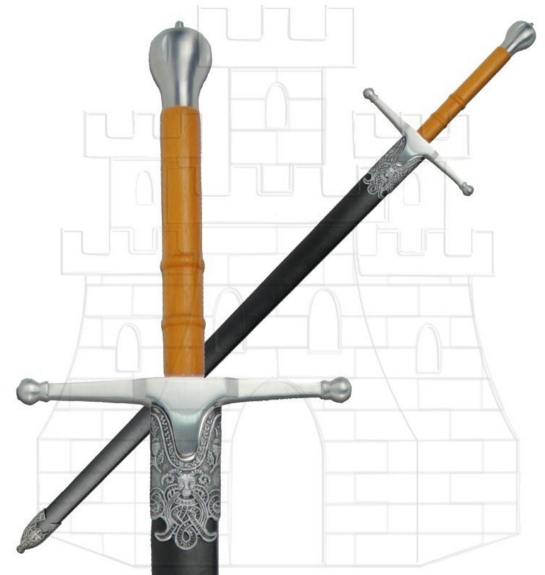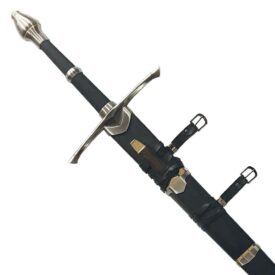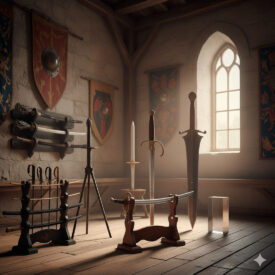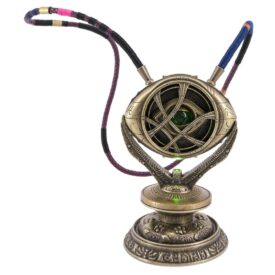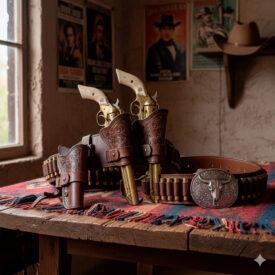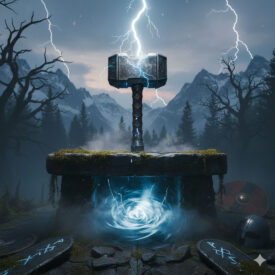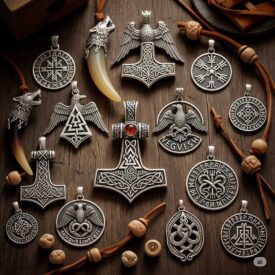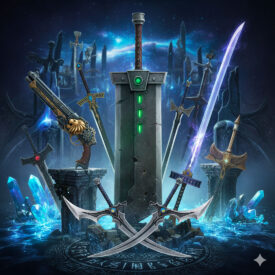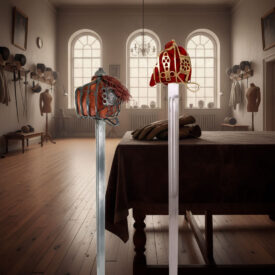At the heart of Scotland’s history stands a legendary figure: Sir William Wallace. His life and deeds have inspired generations, but few objects symbolize his fight for Scottish independence quite like his iconic sword. Immortalized in popular culture—especially thanks to films like Braveheart—Wallace is a central figure in the Scottish Wars of Independence (1296–1357), first as a military leader and then as a powerful symbol. But what about his famous sword? Is the weapon displayed today at the National Wallace Monument the same one he wielded in the heat of battle? Join us on a journey through time to unravel the mystery of this fascinating artifact.
The Enigmatic Sword of William Wallace: Reality or Legend?
Currently, what is believed to be the sword of William Wallace resides in the prestigious Hall of Heroes Gallery at the National Wallace Monument in Stirling, Scotland. At first glance, it impresses with its size. It weighs about 2.7 kilograms (5.95 pounds), with a blade 132 centimeters (4 feet 4 inches) long and an overall length of 163 centimeters (5 feet 4 inches) including the grip. It is, without doubt, an imposing two-handed sword, fit for a legendary hero.
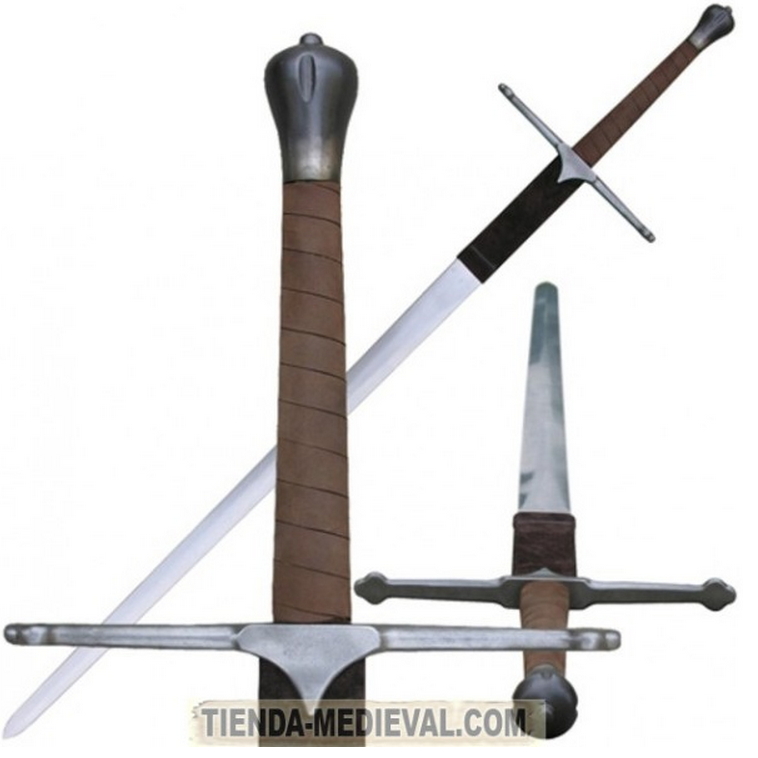 Image: Replica of William Wallace’s Sword.
Image: Replica of William Wallace’s Sword.
An Uncertain Journey Through History
The history of the sword is as captivating as it is mysterious. It is thought to have been in use at least until the Battle of Falkirk in 1298, and possibly until Wallace’s death in 1305. After his capture and handover to the English by John de Menteith, the sword’s trail becomes obscure. For the next 200 years, there is no mention of the sword in the records.
Its documented reappearance occurs in 1505, when King James IV of Scotland paid 26 shillings to an armourer for several repairs, including a new “binding with silk cords”, a new grip and pommel, and a new scabbard and belt. It was rumored that Wallace’s original scabbard, grip, and belt were made from the tanned skin of Sir Hugh Cressingham, the treasurer of the English administration in Scotland—a detail that adds a macabre twist to the legend.
After this, the trail again becomes uncertain until 1644, when a sword matching the description appears in the Wallace Tower at Dumbarton Castle. In 1825, the sword was examined by Sir Samuel Meyrick, an authority on antique swords, who concluded that its fittings were from the same period as a sword from Chester County (1475), a fact that—even if it doesn’t rule out the blade’s antiquity—would fuel future controversy.
The Whirlwind of Controversy: Is It Authentic?
Despite its revered status, the authenticity of Wallace’s sword is surrounded by considerable controversy. One of the main arguments against it is its size: it is so large it could not have been wielded on horseback. Also, even for use on foot, it is estimated that Wallace would have had to be at least 1.96 meters (6 feet 5 inches) tall, while the average height at the time was around 1.7 meters (5 feet 7 inches).
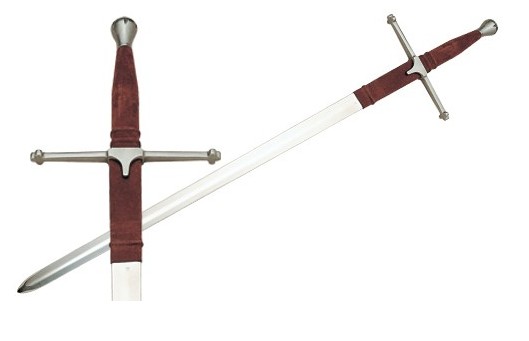 Image: Detail of William Wallace’s Sword.
Image: Detail of William Wallace’s Sword.
Historian David Caldwell has shed more light on these doubts, stating that the current blade appears to have been “forged from at least three separate pieces.” Caldwell has even claimed that the sword in the National Wallace Monument “has nothing to do” with the leader of the First War of Independence. According to him, the sword’s association with Wallace is the result of a “great desire to find appropriate relics” during the construction of the Monument in the nineteenth century. The connection of the sword with Wallace dates back only to 1803, making it a modern legend.
Wallace’s Sword and the Claymore: Clearing Up Confusion
It is common for the “sword of William Wallace” to be confused with a “Claymore”. However, it’s important to understand the distinctions. The term ‘Claymore’ comes from the Gaelic “claidheamh mór”, which means “great sword” and is an iconic symbol of Scottish warfare.
There are two main types of Claymore:
- The two-handed Highlands Claymore: Developed between the 15th and 17th centuries, it was a massive sword, often over 140 cm (55 inches) long. Its most distinctive feature was its guard curving downward and outward, often with ends shaped like a four-leaf clover.
- The one-handed Lowlands Claymore: Appeared later, at the end of the 16th and beginning of the 17th century. It was shorter and lighter, with an elaborate basket hilt to protect the hand.
The sword currently displayed as Wallace’s is a large two-handed sword. However, doubts about its authenticity and analyses that suggest its blade may be an “extension” of an earlier sword distance it from being a “typical” Claymore from the time period when this type of sword developed (15th–17th centuries). The sword in the movie Braveheart, meanwhile, is a “highly stylized and fantastical” representation that matches no historical sword.
The Legacy of William Wallace’s Sword
Despite his death at the hands of the English in 1305, William Wallace’s legacy endures in Scottish history and culture. His courage and sacrifice in the fight for independence inspired other Scottish leaders and ultimately led to Scotland’s independence. The story of William Wallace has been immortalized in various ways over the years, from poems and songs to famous movies like “Braveheart” that helped popularize his story worldwide and keep his memory alive.
A Symbol That Transcends Authenticity
Despite ongoing controversy about its authenticity, Wallace’s sword has maintained and gained immense symbolic value over the centuries. It became a powerful emblem of Scottish resistance and patriotism, especially during the nationalist revival of the nineteenth century. As Ken Thomson from Stirling District Tourism points out, the sword represents “Wallace’s fight for freedom”. Elspeth King summarizes its meaning succinctly: “Wallace’s sword has had great symbolic importance for people over the centuries. It is on public display at the National Wallace Monument, and every Scot should look at it, study it, and think about what it means in the history of Scotland.”
Modern Challenges and Its Ongoing Legacy
The sword has not been free from “disturbances” in its modern home. In 1912, suffragette Ethel Moorhead broke its display case. In 1936 and again in 1972, the sword was stolen by Scottish nationalists from the University of Glasgow, though it was returned both times. More recently, in March 2023, “This Is Rigged” activists vandalised the sword’s display during an oil protest, which led to its temporary removal and the installation of a new display case. In May 2023, the sword returned triumphantly to its home at the Monument, reaffirming its place as an iconic centerpiece.
History may never know for sure if the sword on display today was the same one wielded by the legendary William Wallace. However, what we do know is that, beyond the question of authenticity, Wallace’s sword remains a powerful symbol embodying Scotland’s indomitable spirit, its fight for independence, and the courage of a man who became a legend. It is a tangible reminder of a rich history, inviting every visitor to reflect on what it means for a nation.
Find Your Own William Wallace Sword!
The search for Wallace’s original sword has been a constant quest for historians and history lovers. Although the real sword has yet to be discovered, its absence has not diminished its importance in Scotland’s history. If you wish to explore more about William Wallace’s sword and other historical swords, we invite you to discover the wide selection of Wallace sword replicas and other iconic swords in history.
Step into the past and discover the weapons that forged the history and legacy of great warriors. Each sword tells a story, and Wallace’s sword tells a tale of bravery and resistance that must never be forgotten. Join us on this journey through time and Scottish history!
